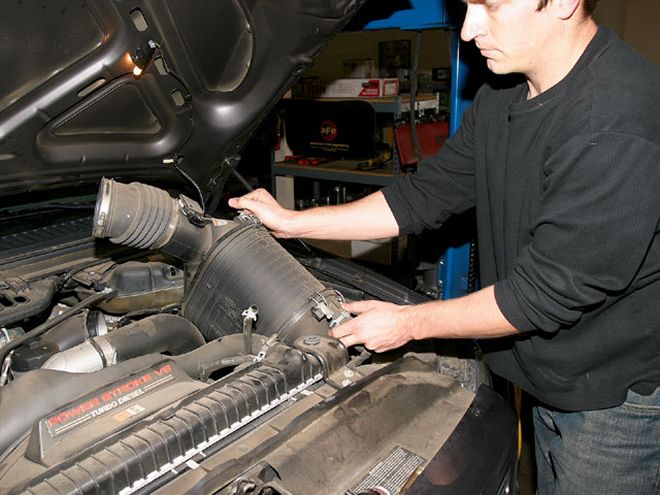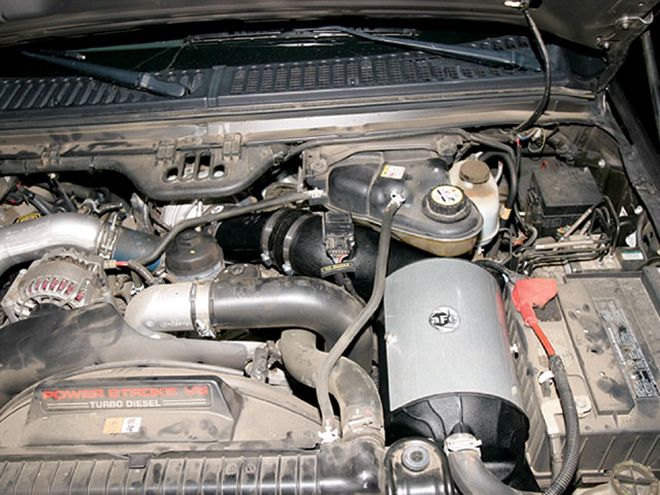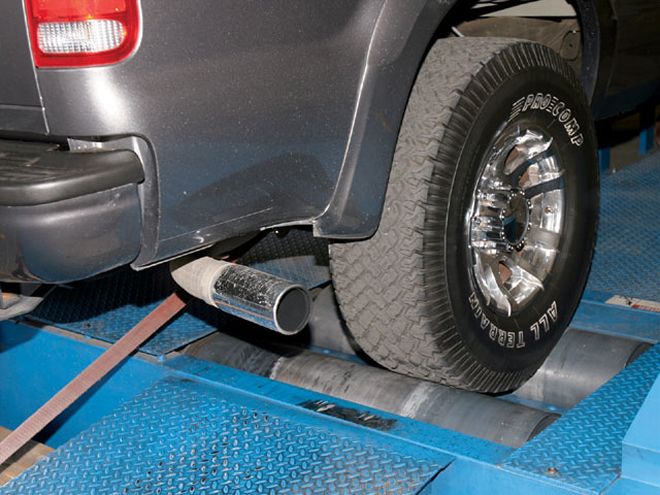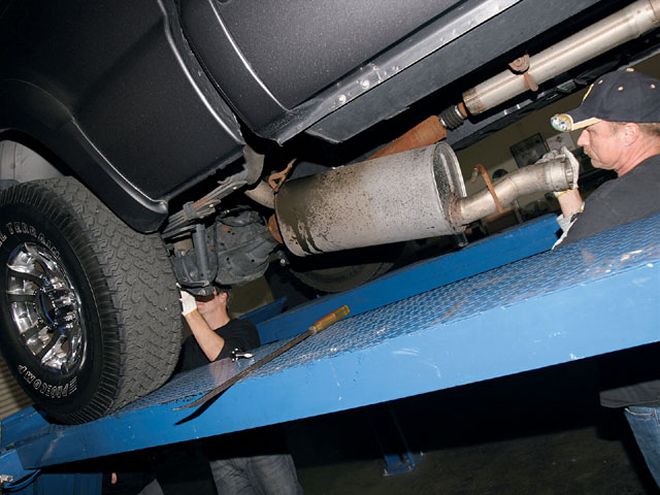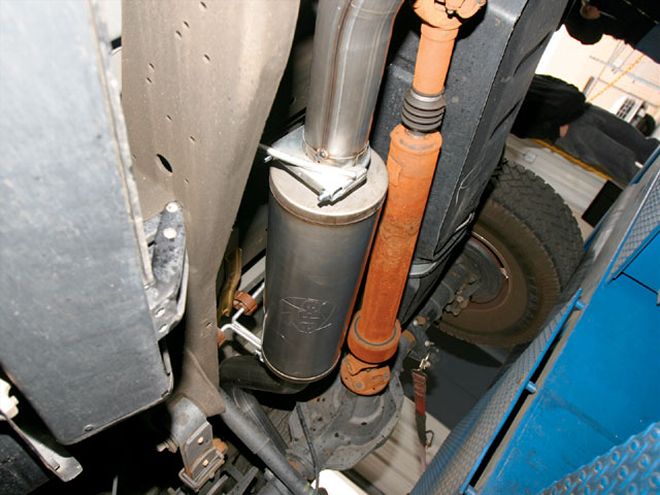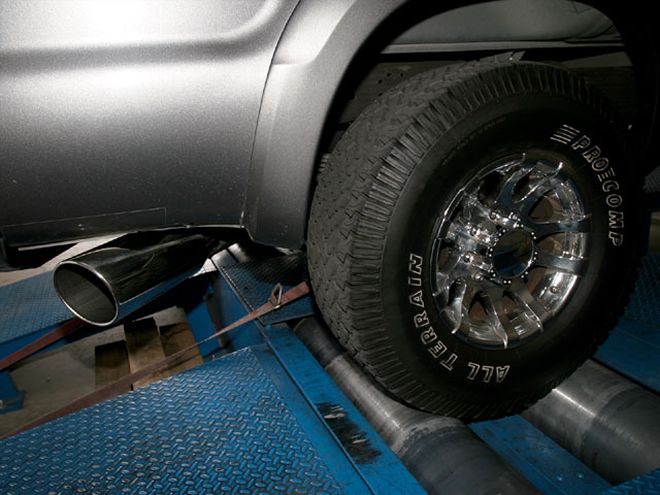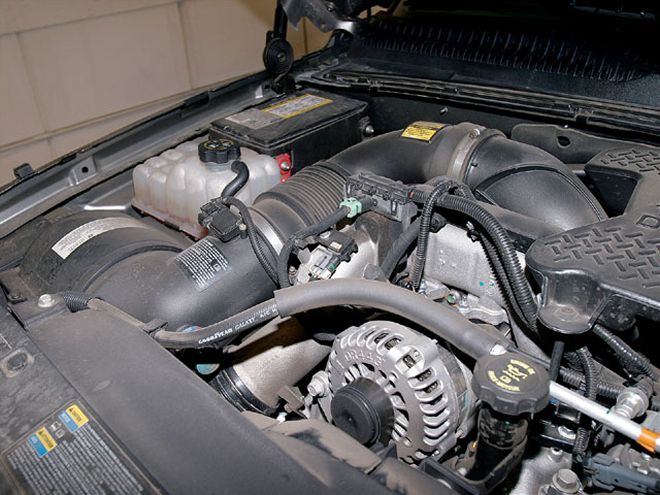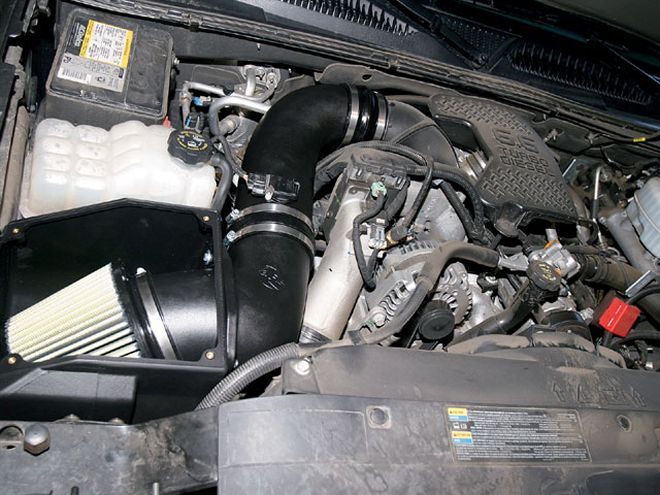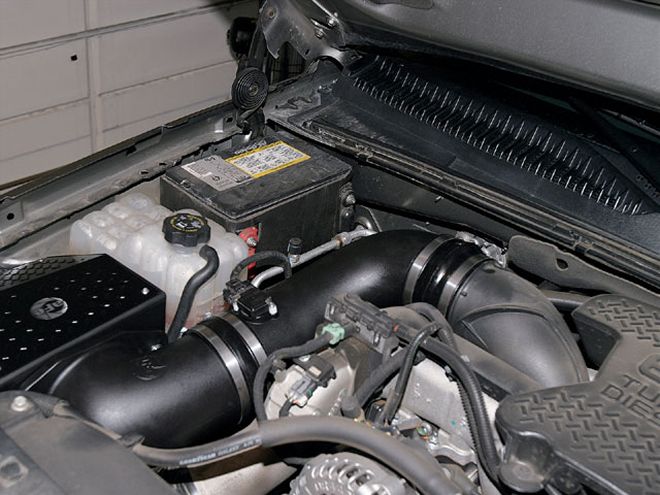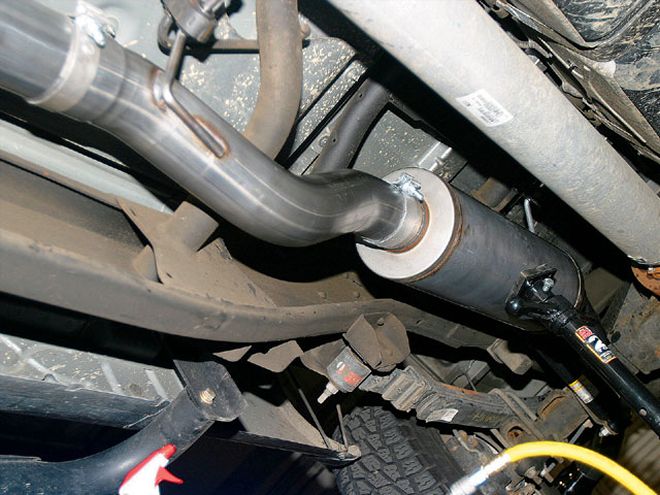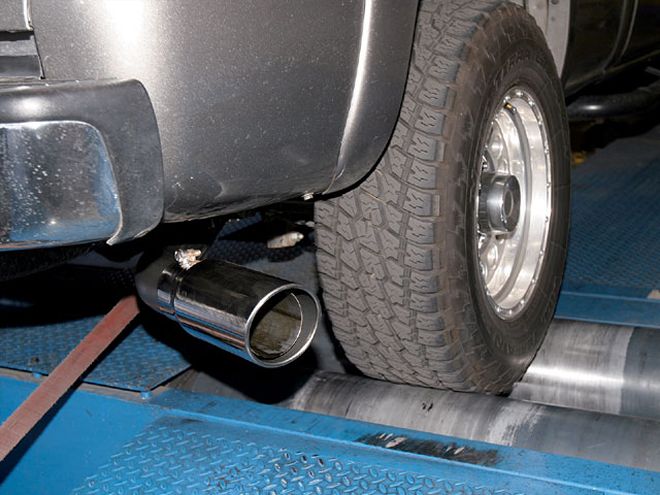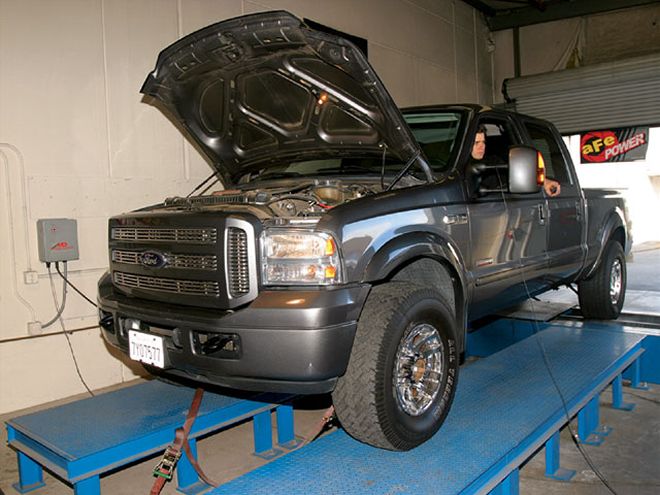
| 2006 Ford F350 Vs 2007 Chevy Silverado ford F350 Dyno
Recently, we took a trip down to Advanced Flow Engineering in Corona, California, to witness another chapter of the age-old Ford vs. Chevy battle. With the keys in our hands to an '06 6.0L Ford and an '07 LBZ Chevy, courtesy of Laguna Speed, we were ready to let the sparks fly. Both trucks would be dyno'd in stock form to get a baseline, then fitted with AFE intakes and exhaust kits, and tested again. Finally, an aftermarket programmer provided by Rolling Big Power would be added to both trucks for their final runs.
FordThe Ford was first on the dyno, and had the added benefit of a factory boost gauge so we could monitor any change in boost once the intake and exhaust were added. In stock form, the Ford put down 242 hp and 611 lb-ft to the rear wheels, while the boost gauge swung up to 25 psi. After the intake and exhaust were added, the boost hit 29 psi (a big improvement) but horsepower and torque climbed only slightly, up to 246/621. We realized that more airflow wasn't going to help us without more fuel, so the 10-level RBP programmer was added. On Level 8, the Ford made a big jump in power, up to 334 horsepower and 687 lb-ft of torque. We tried Level 10, which was a bit much for the stock transmission, and while horsepower remained pretty consistent at 335, torque shot up to 718 lb-ft. Overall, the Ford had gained 93 horsepower and 107 lb-ft of torque.
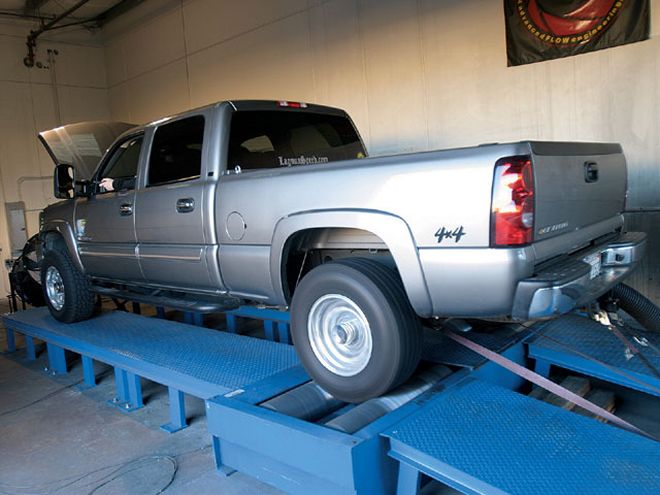
| 2006 Ford F350 Vs 2007 Chevy Silverado chevy Silverado Dyno
ChevyThe Chevy started the day at a whopping 309 rear wheel horsepower, while torque was a healthy 626 lb-ft. With those kind of numbers as a baseline, we had a feeling which brand would end up with the most overall horsepower. First, the intake and exhaust were added, and the silver Chevy's numbers rose slightly to a peak of 314/635. As with the Ford, we figured the big numbers would appear when more fuel was added, so the RBP programmer was plugged into the LBZ and set on Level 4 (the highest setting). All eyes were on the hopped-up Chevy to make some Ford-beating numbers, and the truck didn't disappoint. With the added fuel, the Duramax cranked out 383 rear wheel horsepower, and 758 lb-ft of torque. The final tally for the intake-exhaust-programmer setup for our Duramax was 74 horsepower and 132 lb-ft over stock.
So Who Won?Well, the Ford gained more horsepower during our little shoot-out, but the Chevy made much more torque with the added parts, as well as having higher overall power and torque numbers. Intake and exhaust upgrades did help both trucks produce more power, but the best gains will be seen in conjunction with a programmer. As far as Ford vs. Chevy, we'll have to give this round to Chevrolet.
The ResultsFordStock242 hp/611 lb-ft
Intake and Exhaust:246 hp/621 lb-ft
Intake, Exhaust and Programmer:335 hp/718 lb-ft
ChevyStock:309 hp/626 lb-ft
Intake And Exhaust:314 hp/635 lb-ft
Intake, Exhaust And Programmer:383 hp/758 lb-ft
EGTs and MPGsOne Of The Biggest Benefits Of Installing An Intake and exhaust is that they lower your exhaust gas temperatures (EGT). However, since both trucks were as stock as stock could be, neither one had a pyrometer to measure any drops. In addition to lower EGTs, an intake, exhaust, and programmer can be used to increase your fuel mileage. Both the Chevy and the Ford showed an average improvement of over two miles per gallon after the intake, exhaust and programmer were installed.
 | 2006 Ford F350 Vs 2007 Chevy Silverado ford F350 Dyno
Recently, we took a trip down to Advanced Flow Engineering in Corona, California, to witness another chapter of the age-old Ford vs. Chevy battle. With the keys in our hands to an '06 6.0L Ford and an '07 LBZ Chevy, courtesy of Laguna Speed, we were ready to let the sparks fly. Both trucks would be dyno'd in stock form to get a baseline, then fitted with AFE intakes and exhaust kits, and tested again. Finally, an aftermarket programmer provided by Rolling Big Power would be added to both trucks for their final runs.
FordThe Ford was first on the dyno, and had the added benefit of a factory boost gauge so we could monitor any change in boost once the intake and exhaust were added. In stock form, the Ford put down 242 hp and 611 lb-ft to the rear wheels, while the boost gauge swung up to 25 psi. After the intake and exhaust were added, the boost hit 29 psi (a big improvement) but horsepower and torque climbed only slightly, up to 246/621. We realized that more airflow wasn't going to help us without more fuel, so the 10-level RBP programmer was added. On Level 8, the Ford made a big jump in power, up to 334 horsepower and 687 lb-ft of torque. We tried Level 10, which was a bit much for the stock transmission, and while horsepower remained pretty consistent at 335, torque shot up to 718 lb-ft. Overall, the Ford had gained 93 horsepower and 107 lb-ft of torque.
| 2006 Ford F350 Vs 2007 Chevy Silverado ford F350 Dyno
Recently, we took a trip down to Advanced Flow Engineering in Corona, California, to witness another chapter of the age-old Ford vs. Chevy battle. With the keys in our hands to an '06 6.0L Ford and an '07 LBZ Chevy, courtesy of Laguna Speed, we were ready to let the sparks fly. Both trucks would be dyno'd in stock form to get a baseline, then fitted with AFE intakes and exhaust kits, and tested again. Finally, an aftermarket programmer provided by Rolling Big Power would be added to both trucks for their final runs.
FordThe Ford was first on the dyno, and had the added benefit of a factory boost gauge so we could monitor any change in boost once the intake and exhaust were added. In stock form, the Ford put down 242 hp and 611 lb-ft to the rear wheels, while the boost gauge swung up to 25 psi. After the intake and exhaust were added, the boost hit 29 psi (a big improvement) but horsepower and torque climbed only slightly, up to 246/621. We realized that more airflow wasn't going to help us without more fuel, so the 10-level RBP programmer was added. On Level 8, the Ford made a big jump in power, up to 334 horsepower and 687 lb-ft of torque. We tried Level 10, which was a bit much for the stock transmission, and while horsepower remained pretty consistent at 335, torque shot up to 718 lb-ft. Overall, the Ford had gained 93 horsepower and 107 lb-ft of torque.
 | 2006 Ford F350 Vs 2007 Chevy Silverado chevy Silverado Dyno
ChevyThe Chevy started the day at a whopping 309 rear wheel horsepower, while torque was a healthy 626 lb-ft. With those kind of numbers as a baseline, we had a feeling which brand would end up with the most overall horsepower. First, the intake and exhaust were added, and the silver Chevy's numbers rose slightly to a peak of 314/635. As with the Ford, we figured the big numbers would appear when more fuel was added, so the RBP programmer was plugged into the LBZ and set on Level 4 (the highest setting). All eyes were on the hopped-up Chevy to make some Ford-beating numbers, and the truck didn't disappoint. With the added fuel, the Duramax cranked out 383 rear wheel horsepower, and 758 lb-ft of torque. The final tally for the intake-exhaust-programmer setup for our Duramax was 74 horsepower and 132 lb-ft over stock.
| 2006 Ford F350 Vs 2007 Chevy Silverado chevy Silverado Dyno
ChevyThe Chevy started the day at a whopping 309 rear wheel horsepower, while torque was a healthy 626 lb-ft. With those kind of numbers as a baseline, we had a feeling which brand would end up with the most overall horsepower. First, the intake and exhaust were added, and the silver Chevy's numbers rose slightly to a peak of 314/635. As with the Ford, we figured the big numbers would appear when more fuel was added, so the RBP programmer was plugged into the LBZ and set on Level 4 (the highest setting). All eyes were on the hopped-up Chevy to make some Ford-beating numbers, and the truck didn't disappoint. With the added fuel, the Duramax cranked out 383 rear wheel horsepower, and 758 lb-ft of torque. The final tally for the intake-exhaust-programmer setup for our Duramax was 74 horsepower and 132 lb-ft over stock.
